By Lucy Carroll
At a small high school on the Mid North Coast, students are collected each morning from home by a dedicated bus service and breakfast is handed out on arrival.
“We run a kind of school Uber service, where many of our kids are picked up by bus before class starts,” says Ryan Martin, who is in his third year as the principal at Macleay Vocational College.

Macleay Vocational College year 12 student Shantasia Chatfield, with her son Luka, and school principal Ryan Martin.Credit: Trevor Veale
“At least 70 per cent of the students use the transport that we provide, and we go directly to each house to collect them. We don’t go to bus stops.”
Macleay is one of a surging number of independent special assistance schools – there are now almost 100 nationally – set up to provide alternative schooling for disengaged or disadvantaged youth who have fallen out of the mainstream system.
A new report from Independent Schools Australia, released on Wednesday, reveals the number of students in special assistance schools has tripled from 2014 to 2022, with 13,100 students enrolled, accounting for about two per cent of students in the private school system.
Martin says Macleay, which is based in Kempsey and caters for about 120 pupils from years 9 to 12, is often a lifeline for students who have dropped out of mainstream schools, and describes the trauma experienced by some children as “eye-watering”.
“Most have had pretty poor experiences at school, so they’ve missed a lot of class time and we are often picking up the pieces. They might have been suspended or expelled, had juvenile justice issues, or they were bullied,” says Martin. “If they want to stay involved in education we can offer that, with small class sizes and a safe and supportive environment.”
The school provides breakfast, recess and a home-cooked lunch, and also runs a mothers and babies program that allows young parents to attend classes while their babies and toddlers are cared for in an adjacent crèche.
“The way we look at it is if a student is hungry or cold, they can’t learn. We are trying to remove hurdles away that are prohibitive to learning.”
Fees are a few hundred dollars a year, Martin says, with the school largely supported by state and federal funding. In 2021, private special assistance schools received 77 per cent of recurrent funding from the federal government, 18 per cent from states, and the remainder from parents and other contributions.

Macleay Vocational College students Shellandra Tighe and Shantasia Chatfield with principal Ryan Martin at the school’s creche. Credit: Trevor Veale
Chief executive of Independent Schools Australia Graham Catt attributed rising enrolments in special assistance schools in part to federal government changes introduced in 2014 that “recognised the need to support students who come from disadvantaged backgrounds or who live with disability”.
“The introduction of loadings to address disadvantage has enabled more schools to specialise in supporting the students who need it. Alternative pathways in education are now more accessible for students who might otherwise continue on a negative life trajectory,” Catt says.
Under the Schooling Resource Standard (SRS), there is a base amount for each student, and extra loadings for different types of disadvantage, such as disability or Indigenous heritage.
While Martin says Macleay “used to have a bit of a reputation as a boxing ring”, that has improved, and the school now runs a Friday food drop program where extra meals are donated to families.
“For many of our students this is often their second, third or fourth chance at school.”
Year 12 student Shantasia Chatfield, whose two-year-old son attends the school’s crèche, said she dropped out of a mainstream school after becoming pregnant with her first child.
After leaving a violent domestic relationship, Chatfield joined Macleay last year with a goal to complete the HSC.
“Anything that puts a barrier in the way of school just makes it so much more difficult. Having family issues, or no transport or if you can’t afford books or food. The teachers here go out of their way to make it work. And it’s a school for troubled kids, so there are many extra responsibilities for the school,” she says.
In the last two years, Martin said the school has seen 40 students complete year 12, with many going through hospitality, business and primary industry VET courses.
“Last year of the 20 that finished, 15 gained employment. We measure success on the exit outcomes of the students,” he says.
Education researcher Professor Kitty te Riele, from the University of Tasmania, said the report shows there is huge diversity of schools across the independent sector.
“The growth in student numbers has been a steady growth, it’s not come out of the blue. There clearly is a demand for a different way of providing education and independent schools have been picking this up.”
The Morning Edition newsletter is our guide to the day’s most important and interesting stories, analysis and insights. Sign up here.